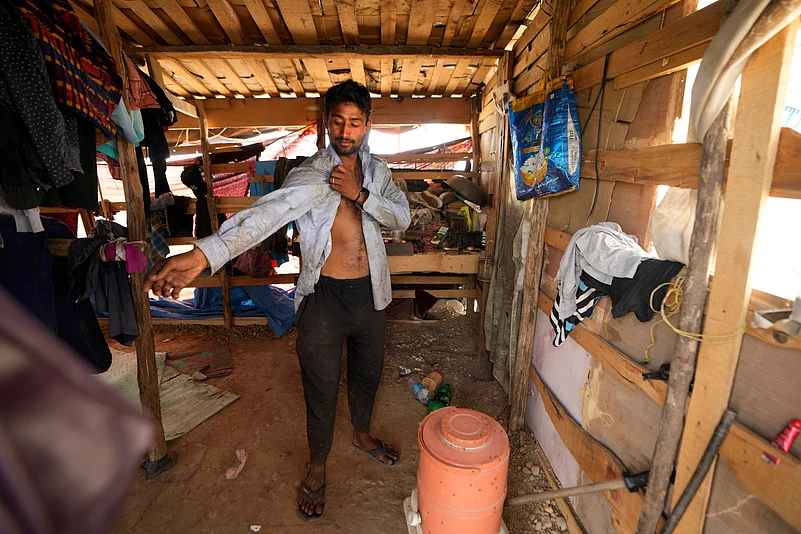Severe heat waves in Delhi and other parts of India have raised serious health concerns. With record-breaking heatwaves sweeping across countries and with maximum temperatures rising every year, millions of lives are threatened globally. According to The 2023 Report of the Lancet Countdown on health and climate change economic losses related to global heating affect livelihood directly.
As summer heat waves intensify, climate justice advocates are calling for access to cooling to be treated as a fundamental right. The World Bank in its report, Climate Investment Opportunities in India’s Cooling Sector (2023) states: “Thermal comfort is not a luxury but a human right for all”.
Lack of climate-centric urban planning, unbridled real estate expansion, poorly designed buildings that trap heat, and cutting trees have all added to the high heat distress.
With the world heating up, billions of people need air-conditioning. Once a luxury, ACs have become a necessity. Of the two billion AC units across the globe, the majority are concentrated in high-income countries. In the hottest regions, AC ownership is just 12 per cent compared to more than 90 per cent in the U.S. and Japan. Almost two and a half billion people do not have access to cooling solutions - the majority in Africa and Asia.
According to the UN Environment Programme (UNEP), demand for cooling is expected to triple by 2050. Understandably, this has also created anxiety over the climate threat of a world already overrun with energy-guzzling ACs. That is troubling news for a warming planet.
So How to Fix the Paradox?
While growing cooling demand is a major concern; it is also essential for survival. Solutions aimed at providing comfort in heat stress need to be undertaken in harmony with the health of the planet. Sustainable cooling is the way forward. Sustainable cooling refers to actions across all cooling sectors that move towards net zero emissions by 2050.
The India Cooling Action Plan (ICAP), 2019 outlines actions for sustainable cooling. It provides an integrated vision towards cooling across sectors, reduction of cooling demand, refrigerant transition, enhancing energy efficiency and better technology options by 2037-38. While sustainable systems may have higher upfront costs, they may offer significant savings in energy and maintenance expenses over their lifespan. Today, energy-efficient ACs are not necessarily more expensive than low-efficiency ones.
The performance of energy-efficient ACs may get further enhanced through better construction of buildings to reduce heat gain. This is particularly important given the contribution of the building sector to emissions.
Reducing temperatures in buildings through passive cooling, better building design, orientation and layout, natural ventilation, shading, climate-friendly building materials, insulation, glazing, reflective surface and paints, green roofs and harmonising construction with nature are some advisable measures.
Ambient cooling measures use nature to reduce the sun’s intensity, such as covering building roofs or balconies with plants to absorb heat. Vegetation has a cooling effect through shading and evapotranspiration. Potted plants and creepers on roofs can reduce indoor temperatures by two point five degrees Celsius.
In Ahmedabad, under a partnership between the municipal corporation, the Indian Institute of Public Health and the Natural Resource Defence Council, more than 7,000 low-income household roofs have been painted white. Painting roofs and sun-facing walls with solar reflective paint can reduce indoor temperatures by up to five degrees Celsius. It is estimated that such initiatives save an estimated 1,100 lives every year.
Several passive cooling measures are low-cost. As the construction industry develops and innovates with better building standards, the costs will fall further. Many architects are reviving vernacular design techniques to construct comfortable, low carbon buildings. The manipulation of architectural elements, for instance, using lattices or jaali, building envelopes, and customising climate-suitable building material, is helping reduce the urban heat island effect and provide thermal comfort.
Nowadays, experts are also advocating the adoption of district cooling systems (DCS). These centralised cooling systems provide chilled water to multiple buildings through underground insulated pipes. Each building has a heat exchanger unit that transfers cooling energy from the chilled water to the building’s internal cooling system, which helps cool the building. After absorbing heat from the buildings, the warm water returns to the central plant. The water is re chilled and then recirculated back to the buildings.
Adopting the system may cut India’s power bill by 40 per cent, and unlike ACs, a DCS does not impact the micro-climate. DCS can be integrated with renewable energy, like solar. Many residential complexes in metros have successfully adopted DCS.
WAVIN, a World Economic Forum innovator, builds green roofs that capture rainwater, which is recycled for irrigating the greenery on the roof, flushing the building’s toilets, and cooling the building during the summer heat.
When a building is constructed, cooling is always an afterthought and left at the discretion of end users, unlike electricity, water supply or sewage management. It makes huge sense to incorporate a cooling mechanism during the planning stage itself.
Till such time The Council on Energy, Environment and Water (CEEW) advises that good AC practices can reduce the carbon footprint and decrease electricity bills. Keeping ACs at 24 degrees Celsius or above can save up to six per cent of the power consumed. Regular servicing of ACs can keep the momentum to 95 per cent of the unit’s original efficiency.
Cleaning air filters periodically could lead to energy savings of 15 per cent. Sustainable cooling solutions will take time to set in. Measures like access to drinking water, providing shaded or covered corridors for hawkers, planting roadside trees, green pavements, shelter stations on roads for pedestrians, and community cooling centres for low-income populations could be small but effective ways to beat the heat.
About the author: Feza Tabassum Azmi is a Professor at the Faculty of Management Studies & Research, Aligarh Muslim University. She is the author of Strategic Human Resource Management published by Cambridge University Press.


















